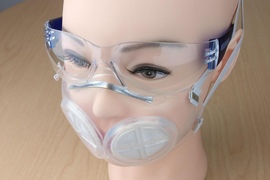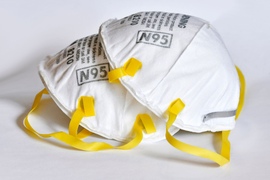The research described in this article has been published as a working paper but has not yet been peer-reviewed by experts in the field.
Masks reduce the spread of Covid-19. But just how much of an effect do they have? A study co-authored by an MIT professor finds that if the U.S. had introduced a uniform national mask mandate for employees of public-facing businesses on April 1, the number of deaths in the U.S. would likely have been 40 percent lower on June 1.
“It is a very effective policy that includes relatively little economic disruption,” says Victor Chernozhukov, a professor in the Department of Economics and the Statistics and Data Science Center at MIT, and one of the authors of a paper detailing the study’s results. “We found it produced a considerable reduction in fatalities.”
Among other findings about the ongoing pandemic, drawing on the timing of state policy announcements, medical data, and Google mobility data, the study also shows that in the same timeframe, total Covid-19 cases in the U.S. would have likely been 80 percent higher without the stay-at-home orders implemented by the vast majority of states.
Additionally, the researchers evaluated how much the reduction in people’s movement — such as commuting and shopping trips — has followed specific state policies, and how much has stemmed from personal decisions to stay home more often. Their conclusion is that each factor accounts for about half of the decline in physical movement during the pandemic.
The paper, “Causal Impact of Masks, Policies, Behavior on Early Covid-19 Pandemic in the U.S.,” has been posted on the MedRxiv preprint server and as part of the Covid Economics paper series by the Center for Economic Policy Research in London. The authors are Chernozhukov; Hiroyuki Kasahara, a professor at the Vancouver School of Economics at the University of British Columbia; and Paul Schrimpf, an associate professor at the Vancouver School of Economics at the University of British Columbia.
State variation creates room for study
To conduct the study, the economists took advantage of the fact that many U.S. states have implemented mask mandates at different times this year. By examining the before-and-after trajectories of cases and deaths, the study was able to identify the impact of the mask mandates.
To be sure, states also differ from each other in numerous ways that may influence the spread of Covid-19, including demographic factors such as the age and health of state residents; population density; additional state-level policies curbing the spread of Covid-19; and self-directed changes in population movement, in response to the pandemic. The study also accounted for the fact that Covid-19 testing increased during this time.
“The results hold up,” Chernozhukov says. “Controlling for behavior, information variables, confounding factors — the mask mandates are critical to the decline in deaths. No matter how we look at the data, that result is there.”
Specifically, after accounting for those circumstances, the researchers estimated that mask mandates would have produced a 40 percent reduction in deaths, nationally. That finding had a 90 percent confidence interval, which describes the likely range of estimated outcomes. That means mandated mask-wearing would have reduced U.S. fatalities by anywhere from 17,000 to 55,000 from April 1 through June 1.
The 80 percent reduction in cases the researchers attributed to stay-at-home orders also had a 90 percent confidence interval, implying that those policies reduced the overall number of cases by anywhere from 500,000 to 3.4 million between April 1 and June 1.
Accounting for movement
In assessing the relationship between public policy and the course of the Covid-19 pandemic, the researchers used Google Mobility Reports data to assess a related question: To what extent does people’s behavior respond to state policy mandates, or to what extent does it stem from “private” or self-directed decisions, based on other information about the public-health situation?
The Google data included mobility measures showing the prevalence of visits to public transit, grocery stores, other retail establishments, and workplaces. Ultimately — again based on the timing of changes in mobility patterns in relation to state-level stay-at-home directives — the researchers concluded that adherence to government mandates accounts for about half of the observed reductions in travel.
“We compute that the policies played an important role, but also that the private responses of people played an equally important role,” Chernozhukov says. “It’s a combination of the two."
The researchers note that they could not measure the effects of all important policy decisions on the reduction of Covid-19 transmission. Consider the school closures that occurred almost nationwide in mid-March: Because the timing of that policy change was so similar across the country, it is very difficult to estimate its effects. If some states had left their schools open longer, it would be easier to quantify what difference the closures made.
“We couldn’t reliably answer that question with our data because the school closures happened almost in one week, with very little variation,” Chernozhukov observes.
However, given that many states have continued changing their policies after June 1, with significant variation in state-level mask policies and economic reopening plans, the scholars say they are continuing to study the subject, and plan to release more findings about it in the near future.
“We are continuing to analyze these issues, and we hope to produce another paper that focuses on the effects of mask mandates during the reopening phase,” Chernozhukov says.









